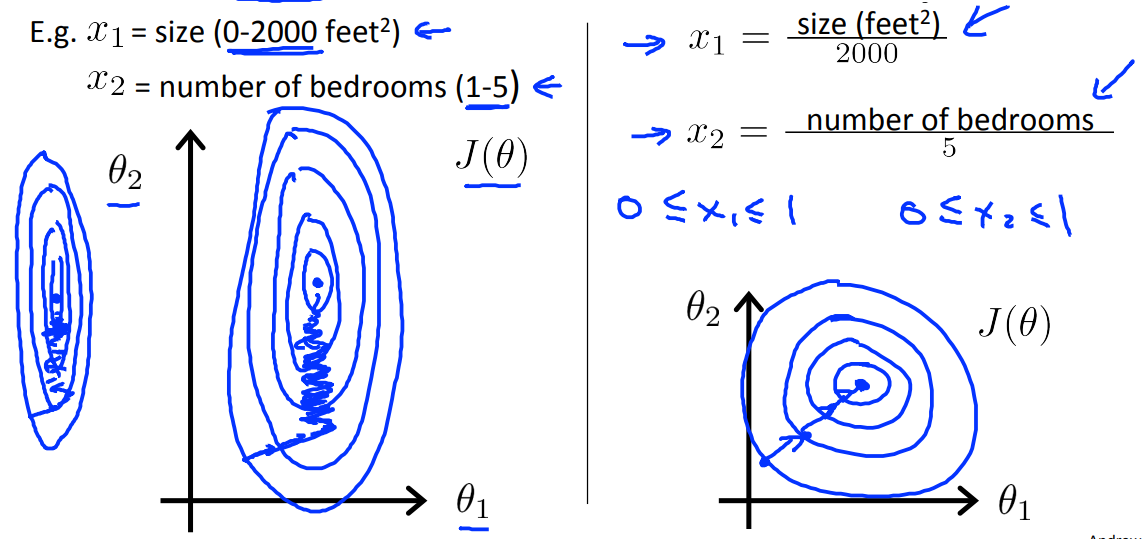1. 模型描述
同 单元线性回归 的例子,现在在已知房子 尺寸大小 的情况下,再额外考虑 房间数目、层数、房屋建成年龄 对 房屋价格 的影响。

设假设函数如下:
其中,变量描述如下:
- 和 代表特征和标签集合
- 代表第 个样本, 代表第 个样本的标签,而 则代表第 个样本的第 个特征
- 为样本个数, 为特征种类数量
- 为假设函数
- 为参数向量, 代表假设函数的第 个参数
为了方便计算,我们给每个样本的特征加上 这个特征,让假设函数变为如下形式:
2. 代价函数及梯度计算
由上一节所述,则该模型的代价函数可以定义为平方误差函数:
其梯度变化如下:
3. 加快梯度下降的速度
3.1 特征缩放(Feature scaling)
确保特征在相同的值域范围内。假设某个线性回归模型有两个特征,其参数对应 和 ,若其特征 和 的值域范围不一样,则可能在梯度下降的过程中存在在一个方向上走得快,而另一个方向走得慢,导致其在等高线上蜿蜒前进。

3.2 均值归一化(Mean normalization)
将原来的特征 进行均值归一化,使其具有接近 0 的均值,计算公式如下:
3.3 选择合适的学习速率
对于学习速率 :
- 若过小:则梯度下降缓慢,最终趋于收敛。
- 若过大:则 可能不是每一次迭代都会下降,而且可能不会收敛。
则需要我们选择合适的学习速率,建议训练的时候绘制出 在设定学习速率下随迭代次数增加的变化曲线,以找到最合适的学习速率,减少其迭代次数。
学习速率可以按如下序列进行尝试:
4. 案列实现
此处,我们创建一个二元线性回归方程 ,其中 , ,然后通过代码去拟合该直线。
代码
import numpy as np
class MyLiner:
"""
单变量线性函数的拟合类
使用梯度下降法
"""
theta = None
__alpha = 0 # 下降速率
__eps = 0 # 梯度变化小于此精度则认定不在变化
__iters = 0 # 迭代次数
__x = None # 二维
__y = None # 一维
m = 0 # 样本数量
n = 0 # 特征个数
def __h(self, x):
"""
假设函数 h
:param x: 传入特征
:return: 特征 x 在此假设函数下的映射
"""
return np.dot(x, self.theta)
def __J(self):
"""
平均误差函数
:return:
"""
return np.mean((self.__h(self.__x) - self.__y) ** 2) / 2
def __gd(self):
"""
梯度下降以及更新
:return: 更新后的 theta
"""
t_theta = np.zeros(shape=(self.n, 1)) # 创建存放更新后的 theta 列表
for j in range(self.n):
xj = np.array([self.__x[:, j]]).transpose()
t_theta[j][0] = self.theta[j][0] - self.__alpha * np.mean((self.__h(self.__x) - self.__y) * xj)
return t_theta
def __init__(self, alpha=0.1, eps=1e-5, iters=10000):
"""
构造函数
:param alpha: 学习步长
:param eps: 精度
"""
self.__alpha = alpha
self.__eps = eps
self.__iters = iters
def fit(self, x, y):
"""
进行训练
:param x: 特征向量
:param y: 标签
"""
self.m, self.n = x.shape[0], x.shape[1] + 1
self.__y = y
c = np.ones(shape=(self.m, 1))
self.__x = np.concatenate((c, x), axis=1) # 将特征的第一维添加1,方便计算
self.__x, self.__y = self.__x.astype(np.float64), self.__y.astype(np.float64)
# 随机找一个起点
self.theta = np.random.randint(10, size=(self.n, 1))
tj = self.__J()
for i in range(self.__iters): # 进行迭代
self.theta = self.__gd()
tj = self.__J()
return tj
def get_param(self):
"""
获取拟合最优的参数
:return: theta
"""
return self.theta.flatten()
def predict(self, x):
"""
预测
:param x: 要预测的特征
:return: 预测的结果
"""
c = np.ones(shape=(x.shape[0], 1))
x = np.concatenate((c, x), axis=1) # 将特征的第一维添加1,方便计算
return self.__h(x).transpose()
def f(x, a, b):
"""
自定义线性函数
:param a:特征对应的系数矩阵
:param b:常数项
:param x:特征
"""
return np.dot(x, a.transpose()) + b
# 生成 f(x) = b + a[1] * x[1] + a[2] * x[2] + ... + a[n] * x[n]
a = np.array([[4, 3]]) # 系数
b = 1
x = np.random.randint(10, size=(20, a.shape[1]))
# 处理 x 并生成 y
y = f(x, a, b)
# 构建模型
model = MyLiner(alpha=0.01, iters=10000)
res = model.fit(x, y)
print(res) # 输出平均误差 J(theta)
print(model.get_param()) # 假设函数的参数 theta 列表
结果输出
7.868549906123757e-09
[1.00039689 3.99994972 2.99996158]
| 标题: | 机器学习笔记(三)——多元线性回归 |
|---|---|
| 链接: | https://www.fightingok.cn/detail/225 |
| 更新: | 2022-09-18 22:49:46 |
| 版权: | 本文采用 CC BY-NC-SA 3.0 CN 协议进行许可 |





